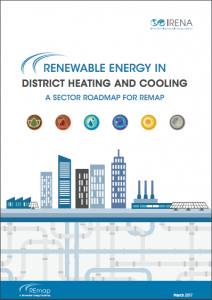Full Title: Renewable Energy in district heating and cooling: A sector roadmap for REmap
Author(s): International Renewable Energy Agency
Publisher(s):
Publication Date: March 1, 2017
Full Text: Download Resource
Description (excerpt):
District heating and cooling (DHC) combined with renewable energy sources can help meet rising urban energy needs, improve efficiency, reduce emissions and improve local air quality. Although currently dominated by fossil fuels such as coal and gas, DHC systems can be upgraded, or new networks created, to use solid biofuel, solar and geothermal energy technologies.
Depending on local conditions, renewable-based DHC brings a range of benefits, including increased energy security, improved health and reduced climate impact.
To date, only a few countries have taken advantage of their renewable resource potential for DHC or created policies to promote further uptake. Sweden and Switzerland have started promoting renewable-based district heating, while Denmark – with ambitious decarbonisation policies –already uses high shares. Many cities and regions envisage a growing role for district in their energy plans; some are also looking increasingly at district cooling.
Accelerating the rise of renewable-based DHC requires action in key areas.
